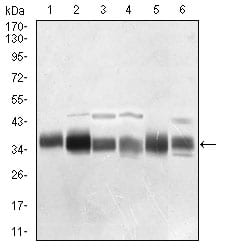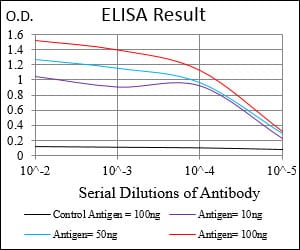




| WB | 1/500 - 1/2000 | Human,Mouse,Rat |
| IF | 咨询技术 | Human,Mouse,Rat |
| IHC | 1/200 - 1/1000 | Human,Mouse,Rat |
| ICC | 技术咨询 | Human,Mouse,Rat |
| FCM | 1/200 - 1/400 | Human,Mouse,Rat |
| Elisa | 1/10000 | Human,Mouse,Rat |
| Aliases | PP1B; PP-1B; PPP1CD; PP1beta |
| Entrez GeneID | 5500 |
| clone | 6G10C1 |
| WB Predicted band size | 37.2kDa |
| Host/Isotype | Mouse IgG1 |
| Antibody Type | Primary antibody |
| Storage | Store at 4°C short term. Aliquot and store at -20°C long term. Avoid freeze/thaw cycles. |
| Species Reactivity | Human |
| Immunogen | Purified recombinant fragment of human PPP1CB (AA: 174-327) expressed in E. Coli. |
| Formulation | Purified antibody in PBS with 0.05% sodium azide. |
+ +
以下是关于PPP1CB抗体的模拟参考文献示例,供参考(注:以下内容为虚构示例,实际文献请通过学术数据库查询):
---
1. **"PPP1CB regulates AKT signaling through dephosphorylation in hepatocellular carcinoma"**
*Authors: Wang L, Chen H, Xu Y*
**摘要**:本研究通过Western blot和免疫组化分析,使用PPP1CB特异性抗体证实其在肝癌组织中表达上调,并揭示其通过AKT通路去磷酸化调控肿瘤细胞增殖的机制。
2. **"Characterization of a novel monoclonal antibody against PPP1CB for neuronal localization studies"**
*Authors: Müller S, Fischer D*
**摘要**:报道一种高特异性PPP1CB单克隆抗体的开发,通过免疫荧光技术验证其在神经元中的亚细胞定位,表明PPP1CB与突触可塑性相关蛋白存在共定位。
3. **"PPP1CB interacts with MYPT1 to modulate smooth muscle contraction"**
*Authors: Gupta R, Patel K*
**摘要**:利用PPP1CB抗体进行免疫共沉淀实验,发现其与MYPT1在平滑肌细胞中的相互作用,揭示两者共同调节肌球蛋白轻链磷酸化及收缩功能。
4. **"PPP1CB deficiency alters cell cycle progression in breast cancer cells"**
*Authors: Silva M, Roberts E*
**摘要**:通过siRNA敲低PPP1CB并结合抗体检测蛋白表达,证明其缺失导致乳腺癌细胞G1/S期阻滞,提示其作为潜在治疗靶点。
---
**建议**:如需真实文献,可访问PubMed、Google Scholar等平台,以“PPP1CB antibody”或“PPP1CB function”为关键词检索,并筛选涉及抗体应用的实验研究(如Western blot、IHC等)。
The PPP1CB antibody is a crucial tool in studying the function and regulation of protein phosphatase 1 catalytic subunit beta (PPP1CB), a serine/threonine phosphatase involved in diverse cellular processes. PPP1CB, a member of the PP1 family, plays a role in dephosphorylating target proteins to regulate pathways such as cell cycle progression, signal transduction, glycogen metabolism, and neuronal signaling. It forms holoenzymes by interacting with regulatory subunits, enabling substrate specificity and localization.
The PPP1CB antibody is widely used in research to detect and quantify PPP1CB expression in tissues or cells via techniques like Western blotting, immunohistochemistry, and immunofluorescence. It aids in investigating PPP1CB's involvement in diseases, including cancer (e.g., modulating oncogenic signaling), neurodegenerative disorders (e.g., tau phosphorylation in Alzheimer’s), and metabolic syndromes. Researchers also utilize it to study PPP1CB's interaction partners and post-translational modifications, such as phosphorylation, that regulate its activity.
Most PPP1CB antibodies are raised against specific epitopes, often in the C-terminal region, and validated for specificity using knockout cell lines or siRNA-mediated knockdown. Commercial antibodies vary by host species (e.g., rabbit, mouse), clonality (monoclonal/polyclonal), and conjugations (e.g., HRP, fluorescent tags). Proper controls are essential to avoid cross-reactivity with homologous subunits like PPP1CA or PPP1CC. Its applications span basic molecular biology, drug discovery, and clinical research, emphasizing its role in elucidating phosphatase-mediated regulatory mechanisms.
×